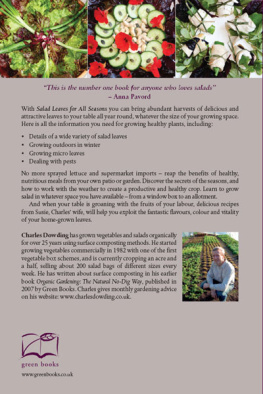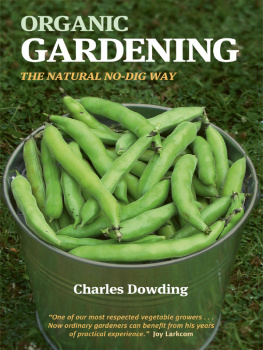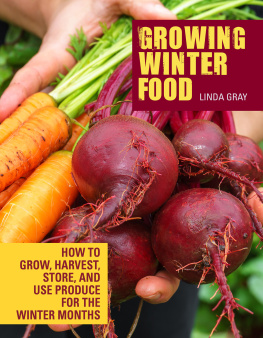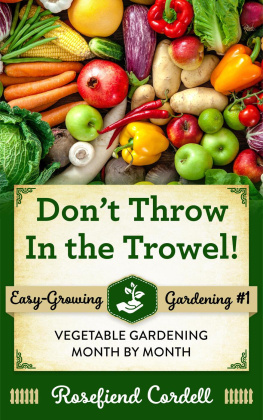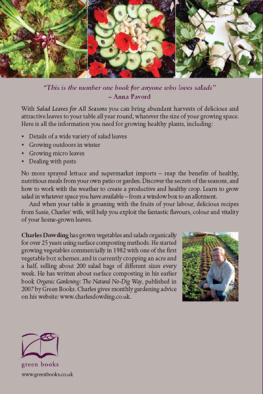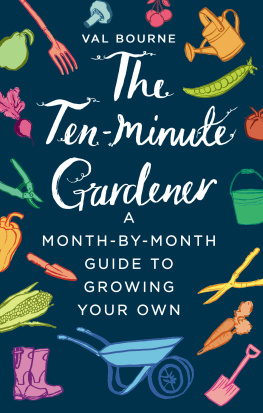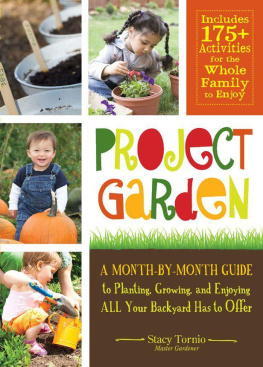How to Grow
Winter Vegetables

How to Grow
Winter Vegetables
CHARLES DOWDING

First published in 2011 by
Green Books,
Dartington Space, Dartington Hall,
Totnes, Devon TQ9 6EN
Reprinted 2011
2011 Charles Dowding
The author hereby asserts his moral rights in accordance with the Copyright, Designs and Patents Act 1988.
All rights reserved
No part of this book may be used or reproduced in any manner without written permission, except in the case of brief quotations in critical articles or reviews.
Photographs by Charles Dowding except for the following:
Jack Dowding: page .
Steph Hafferty: pages .
Lucy Pope: pages .
Design by Jayne Jones. Cover design by Stephen Prior / Jayne Jones
Print edition ISBN 978 1 900322 88 1
PDF format ISBN 978 0 85784 038 7
ePub format ISBN 978 0 85784 103 2
Cover image: Lusia chicory, November.
Back cover images: Left: Sanguina beetroot, October. Middle: Ibis celeriac, October. Right: Apex F1 Chinese cabbage, late November.
Page 2: Sai Sai leaf radish, November. Pages 10-11: Redbor F1 kale, December.
Pages 28-9: Early Purple Sprouting broccoli, late November. Pages 78-9: Barbosa savoy cabbage, December. Pages 146-7: Tardiva chicory hearting up in November.
Pages 170-1: Softneck garlic hung to dry in a barn. Pages 186-7: Salad in December.
Acknowledgements
Thanks to my family and especially Susie for their support. Edwards eyes were raised to the skies when I accepted the commission, and he remarked We know where youll be this winter. Thanks also to Amanda Cuthbert for the idea (after finding her plot annoyingly empty last winter), to Alethea Doran for incredibly thorough editing, and to all the team at Green Books.
To our Earth Mother, giving food when in repose.

Introduction
Welcome to the amazingly varied world of winter produce. This book sets out to widen your winter horizons, revealing the many vegetables that can be grown and enjoyed in the years darker half. Fresh vegetables in winter are even more welcome than in summer some green to alleviate the grey, and flavours that have been sweetened by frost.
You can also enjoy stored harvests, for example, vegetables from sacks in the shed, or ropes of onion and garlic that have been stored under cover.
Some of these vegetables take the main part of a year to grow and mature. Others can be sown after midsummer even in September for winter salad to grow indoors.
I also aim to help you plan and practise a yearly cycle of gardening, so that the harvests of your vegetables in the winter can match the harvests made in summer from the same ground. It is possible to keep sowing and planting through summer so that something is always growing and there is less feast or famine. Many vegetables for winter eating can be slotted into a plot that is also producing regular meals in summer.
I offer the essential knowledge required to grow each vegetable, especially the best time to sow vital information that is often overlooked.
Sowing at the right time helps reduce losses from pests and diseases. The advice here should enable you to unleash the powerful combination of soils ability to confer health to plants, and seeds ability to launch into healthy growth once they have germinated at the most propitious moment.
Parts 4 and 5 give advice on when and how to harvest your vegetables, either for immediate use or for storage because harvesting and storing is as important as growing.
I hope you will glean many tips here that are relevant to your soil (or growing medium) and the amount of time available to you, enabling you to grow healthy plants and harvest them at the best moment. Then you can enter winter with the warming knowledge that a tasty harvest is growing or is safely stored.
Left: Spreading cow manure in December after a harvest of chicory hearts.

Chapter 1
A forgotten season
Making the most of winters amazing possibilities
Winter can offer vegetables in two ways: fresh harvests, such as leeks and salad leaves, and produce such as carrots and onions that have been stored from earlier harvests in the summer and autumn. Having these vegetables to hand can make a huge difference to ones health and well-being through the seemingly long months of cold and dark. The secret to having this produce in winter is to grow throughout the year and to start sowing as early as possible in the spring.
Winters two parts
What do I mean by winter? A precise definition by time is difficult when the seasons overlap so much, and changes in the weather can sometimes make it feel like winter in October and also in April. This book covers the winter half-year, as opposed to the summer half-year, and I define it in two parts.
True winter is under way by December, when growth is almost halted, and continues until March or even April, by which time daylight and some early warmth have returned, although there are still very few fresh vegetables to eat.
Then, in April, May and even into June in a cold spring, there can be a long and frustrating wait for plants to grow and mature. Although the weather may be fine and warm, there is surprisingly little to eat from the garden, in a period known as the hungry gap a kind of second winter in food terms. In the past this period was occasionally characterised by famine as people waited for the first new harvests, such as broad beans.
This book will help you grow vegetables for true winter as well as for this hungry period, winters shadow. You need to garden many months ahead, with sowings of purple sprouting broccoli in June, spring cabbages in August, broad beans in October or November and spinach in early March, all for harvests in the hungry gap.
You will also find lots of advice on helping vegetables survive winter in better shape and then grow strongly again in the spring. A cover of netting, barely visible, can be enough to lessen the effects of frost, wind and snow so that plants endure when they would otherwise have perished. Using fleece in the spring brings growth forwards dramatically. Both of these are simple to use and cheap to buy.
Right: Cavolo Nero kale in early December.
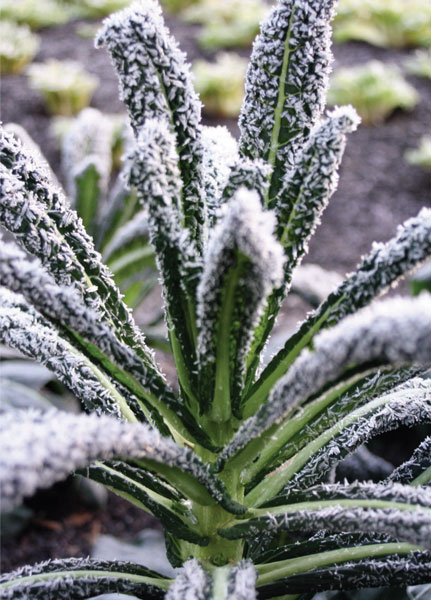
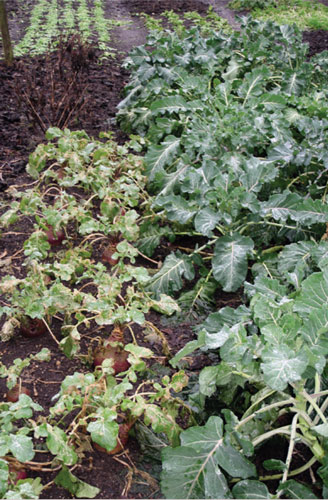
Swede, lambs lettuce and purple sprouting broccoli for harvesting over a long period.
Summer & winter vegetables contrasted
Growing vegetables in summer is a busier activity than in winter, partly because winter vegetables need to be sown, planted and weeded in summer. If the summer is wet and the tomatoes are poor, at least your winter vegetables will be growing well.
Periods of harvest
An important difference between summer and winter vegetables is that in summer many plants such as courgettes, runner beans and tomatoes offer repeated harvests over a long period. Continual summer warmth encourages harvests from the same plants for some time. This can result in summer gluts, and perhaps even some complacency, because winter harvests do not repeat, or do so only slowly.
Next page
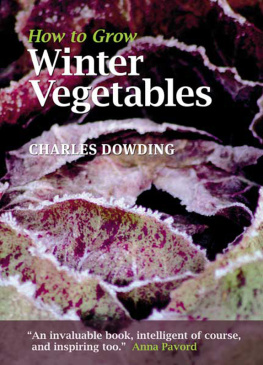
![Dowding - The Year-Round Vegetable Gardener’s Bible [7 Books in 1]](/uploads/posts/book/453239/thumbs/dowding-the-year-round-vegetable-gardener-s.jpg)

